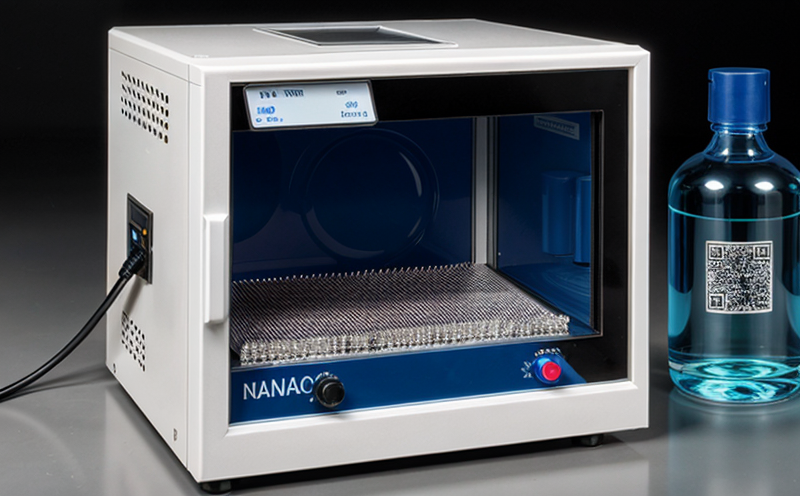CSA Z128 Nanomaterial Workplace Safety Testing
The CSA Z128 Standard is a comprehensive framework designed to ensure the safety of workers exposed to nanomaterials in their workplace. This standard addresses the unique challenges posed by nanoscale materials, which can behave differently from their macroscale counterparts due to increased surface area and quantum effects.
CSA Z128 Nanomaterial Workplace Safety Testing is critical for several reasons. Firstly, it helps organizations comply with stringent regulatory requirements set forth by government bodies like OSHA (Occupational Safety and Health Administration) in the United States. Secondly, it ensures that employers can protect their workforce from potential health hazards associated with nanomaterials.
The testing process involves multiple steps to evaluate various aspects of nanomaterial safety:
- Physical and chemical characterization
- Toxicological assessment
- Inhalation exposure limits determination
- Skin contact risk evaluation
- Evaluation of potential respiratory, dermal, or ocular hazards
The testing protocol is rigorous and involves advanced analytical techniques such as transmission electron microscopy (TEM), scanning electron microscopy (SEM), dynamic light scattering (DLS), and spectroscopy methods to characterize the physical properties of nanomaterials.
One of the key aspects of this service is the determination of inhalation exposure limits. This requires precise measurement of the mass concentration of airborne nanoparticles, which can be challenging due to their small size and high dispersion.
The testing process also involves evaluating the potential for skin contact hazards. This includes assessing the potential for dermal absorption and irritation, which are critical considerations given that nanomaterials can penetrate skin more easily than larger particles.
| Parameter | Description |
|---|---|
| Mass concentration of nanoparticles | Determined using gravimetric methods and laser scattering techniques. |
| Skin irritation potential | Evaluated through in vitro tests on human skin models. |
| Toxicological profile | Assessed based on comprehensive literature review and experimental data. |
| Inhalation exposure limits | Determined using real-time monitoring of airborne nanoparticle levels. |
The service also includes detailed reporting, which provides a clear picture of the nanomaterials' behavior under various conditions. This report is essential for quality managers and compliance officers to make informed decisions about workplace safety measures.
In conclusion, CSA Z128 Nanomaterial Workplace Safety Testing is an indispensable tool in ensuring worker safety and regulatory compliance. By providing a comprehensive evaluation of the potential hazards associated with nanomaterials, this service helps organizations protect their workforce while adhering to international standards.
Why Choose This Test
Selecting CSA Z128 Nanomaterial Workplace Safety Testing is essential for several reasons. Firstly, it ensures compliance with the latest regulatory requirements set forth by OSHA and other governing bodies. Secondly, it provides a clear understanding of the potential hazards associated with nanomaterials, allowing organizations to implement appropriate safety measures.
The testing process is designed to evaluate various aspects of nanomaterial safety, including physical and chemical characterization, toxicological assessment, inhalation exposure limits determination, skin contact risk evaluation, and evaluation of potential respiratory, dermal, or ocular hazards. This comprehensive approach ensures that all relevant factors are considered when assessing the risks associated with nanomaterials.
One of the key benefits of this service is its ability to provide detailed reporting on the nanomaterials' behavior under various conditions. This report is essential for quality managers and compliance officers to make informed decisions about workplace safety measures. Additionally, the testing process involves advanced analytical techniques such as transmission electron microscopy (TEM), scanning electron microscopy (SEM), dynamic light scattering (DLS), and spectroscopy methods to characterize the physical properties of nanomaterials.
The service also includes real-time monitoring of airborne nanoparticle levels, which is essential for determining inhalation exposure limits. This information is critical for developing effective respiratory protection programs and ensuring that workers are not exposed to unsafe levels of nanoparticles.
Another advantage of this service is its ability to evaluate the potential for skin contact hazards. This includes assessing the potential for dermal absorption and irritation, which are critical considerations given that nanomaterials can penetrate skin more easily than larger particles. The testing process involves in vitro tests on human skin models to determine the skin irritation potential.
In conclusion, CSA Z128 Nanomaterial Workplace Safety Testing is an essential service for organizations looking to ensure worker safety and regulatory compliance. By providing a comprehensive evaluation of the potential hazards associated with nanomaterials, this service helps organizations protect their workforce while adhering to international standards.
International Acceptance and Recognition
The CSA Z128 Standard has gained widespread acceptance and recognition in various countries around the world. This standard is widely used by organizations in industries such as electronics, pharmaceuticals, and manufacturing to ensure worker safety when handling nanomaterials.
One of the key reasons for the international acceptance of this standard is its alignment with other global standards such as ISO 14001 and OSHA. The CSA Z128 Standard provides a framework that ensures compliance with these global standards, making it easier for organizations to meet regulatory requirements in multiple countries.
The testing process involved in CSA Z128 Nanomaterial Workplace Safety Testing is recognized by international bodies such as the International Organization for Standardization (ISO) and the American Society for Testing and Materials (ASTM). This recognition ensures that the testing results are valid and reliable, making it easier for organizations to trust the findings.
The standard also provides guidance on how to handle nanomaterials safely in the workplace. This includes recommendations on personal protective equipment (PPE), ventilation systems, and other safety measures. The standard is regularly updated to reflect the latest research and best practices in the field of nanotechnology.
In conclusion, the CSA Z128 Standard has gained widespread acceptance and recognition in various countries around the world. Its alignment with global standards such as ISO 14001 and OSHA makes it easier for organizations to meet regulatory requirements in multiple countries. The testing process involved is recognized by international bodies such as the International Organization for Standardization (ISO) and the American Society for Testing and Materials (ASTM). The standard also provides guidance on how to handle nanomaterials safely in the workplace.





